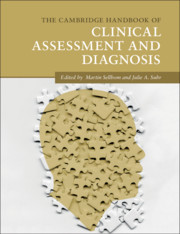Book contents
- The Cambridge Handbook of Clinical Assessment and Diagnosis
- The Cambridge Handbook of Clinical Assessment and Diagnosis
- Copyright page
- Contents
- Figures
- Tables
- Contributors
- Acknowledgments
- 1 Introduction to the Handbook of Clinical Assessment and Diagnosis
- Part I General Issues in Clinical Assessment and Diagnosis
- 2 Psychometrics and Psychological Assessment
- 3 Multicultural Issues in Clinical Psychological Assessment
- 4 Ethical and Professional Issues in Assessment
- 5 Contemporary Psychopathology Diagnosis
- 6 Assessment of Noncredible Reporting and Responding
- 7 Technological Advances in Clinical Assessment
- 8 Psychological Assessment as Treatment
- 9 Writing a Psychological Report Using Evidence-Based Psychological Assessment Methods
- Part II Specific Clinical Assessment Methods
- Part III Assessment and Diagnosis of Specific Mental Disorders
- Part IV Clinical Assessment in Specific Settings
- Index
- References
7 - Technological Advances in Clinical Assessment
Ambulatory Assessment
from Part I - General Issues in Clinical Assessment and Diagnosis
Published online by Cambridge University Press: 06 December 2019
- The Cambridge Handbook of Clinical Assessment and Diagnosis
- The Cambridge Handbook of Clinical Assessment and Diagnosis
- Copyright page
- Contents
- Figures
- Tables
- Contributors
- Acknowledgments
- 1 Introduction to the Handbook of Clinical Assessment and Diagnosis
- Part I General Issues in Clinical Assessment and Diagnosis
- 2 Psychometrics and Psychological Assessment
- 3 Multicultural Issues in Clinical Psychological Assessment
- 4 Ethical and Professional Issues in Assessment
- 5 Contemporary Psychopathology Diagnosis
- 6 Assessment of Noncredible Reporting and Responding
- 7 Technological Advances in Clinical Assessment
- 8 Psychological Assessment as Treatment
- 9 Writing a Psychological Report Using Evidence-Based Psychological Assessment Methods
- Part II Specific Clinical Assessment Methods
- Part III Assessment and Diagnosis of Specific Mental Disorders
- Part IV Clinical Assessment in Specific Settings
- Index
- References
Summary
The advancement and spread of technology have improved options for clinical assessment. Specifically, ambulatory assessment (AA) methods have improved the ability to assess constructs with a particular focus on intra-individual and dynamic time processes, which are highly relevant to the assessment of mood and behavior. This chapter reviews current technologies, including applications of online platforms and devices, often utilized to collect data in an AA framework, and discusses their applications within research and clinical settings (e.g., assessment of mood instability). AA has a number of benefits, including limited or no reliance on retrospective recall as well as the ability to assess context and construct of interest in the “real world,” and allows for the ability to gather rich information regarding mood, behavior, and psychophysiology as part of the clinical assessment process. Much of the clinical application of AA is in the early stages. A number of important considerations and recommendations, including data security, accessibility, and future directions, are also reviewed within the context of AA methods.
Keywords
- Type
- Chapter
- Information
- Publisher: Cambridge University PressPrint publication year: 2019
References
- 1
- Cited by



